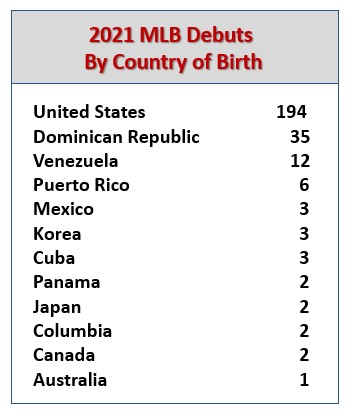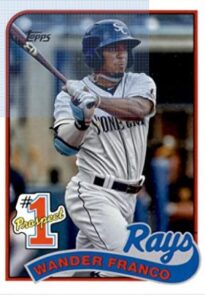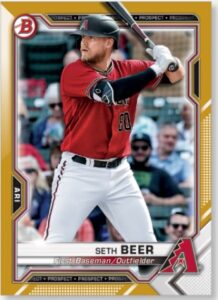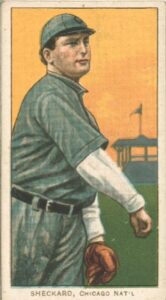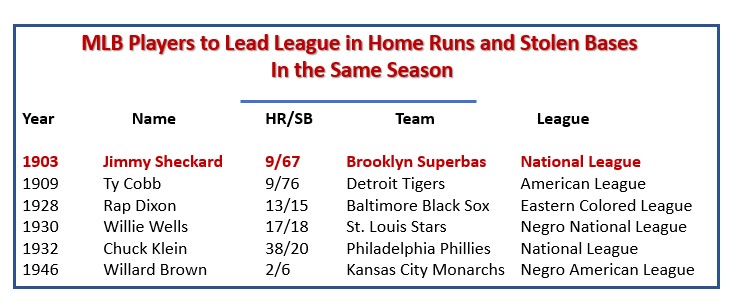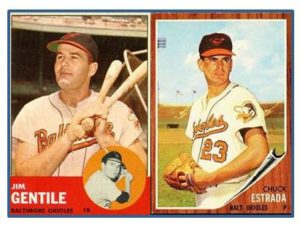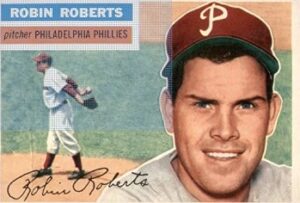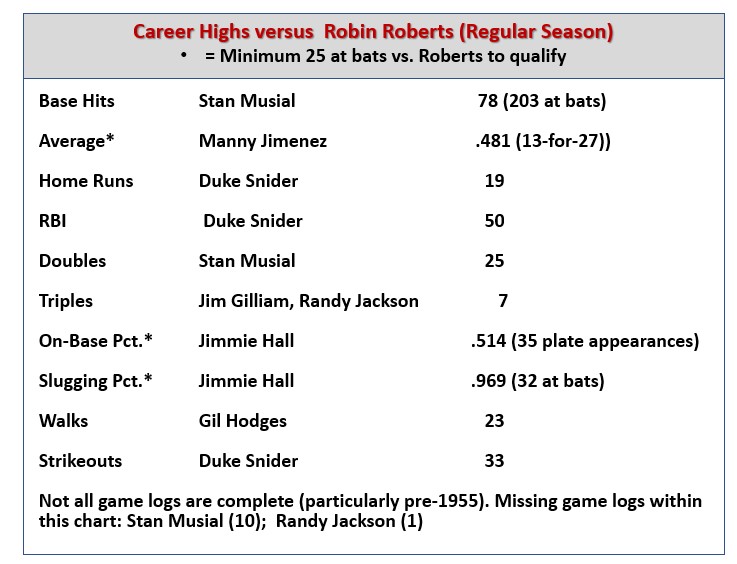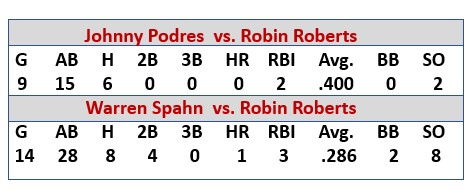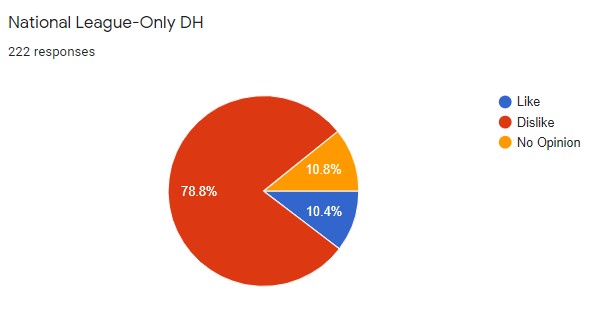I have often noted in this blog how – when I start digging into one baseball event, career or question – “one thing leads to another.” This post is no exception. I started with the intention of looking at who the newest, oldest-ever MLB rookie is, now that Satchel Paige has had to relinquish that crown (with the classification of the 1920-48 Negro Leagues as major leagues). I got a bit sidetracked as my research took me to the player who had the longest minor-league career (16 seasons) before making his MLB debut. We’ll get to Paige’s successor, but first a look at John Lindsey’s remarkable climb to the majors.
How many of us – as baseball fans – would have given anything for even just one at bat in the leagues? Or, if we were really lucky, one hit (or one strikeout or one mound win)? Getting our picture on a big-league baseball card – or our name on a page in The Baseball Encyclopedia would have been heaven.
 Well, John Lindsey accomplished that dream – and, in doing it, showed more perseverance than any major leaguer before or since. Lindsey spent 16 seasons and a combination of 1,571 minor-league games, as well as four seasons and 141 games in the Mexican, Dominican and Venezuelan Winter Leagues, before his September 8, 2010 MLB debut with the Dodgers. Lindsey’s was the longest minor-league “internship” ever before an MLB debut. In fact, before he put on the Los Angeles uniform, he had he had played in the Rockies, Mariners and Dodgers’ systems, suiting up for the:
Well, John Lindsey accomplished that dream – and, in doing it, showed more perseverance than any major leaguer before or since. Lindsey spent 16 seasons and a combination of 1,571 minor-league games, as well as four seasons and 141 games in the Mexican, Dominican and Venezuelan Winter Leagues, before his September 8, 2010 MLB debut with the Dodgers. Lindsey’s was the longest minor-league “internship” ever before an MLB debut. In fact, before he put on the Los Angeles uniform, he had he had played in the Rockies, Mariners and Dodgers’ systems, suiting up for the:
- Arizona Rookie League Rockies;
- Northwest League Portland Rockies;
- South Atlantic League Asheville Tourists (two seasons);
- Carolina League Salem Avalanche (three seasons);
- California League San Bernardino Stampede;
- Florida State League Jupiter Hammerheads;
- Independent Canadian-American Association New Jersey Jackals (two seasons);
- Pacific Coast League Las Vegas 51s (two seasons);
- Dominican Winter league Estrellas de Oriente (San Pedro de Macoris);
- Pacific Coast League New Orleans Zephyrs;
- Southern League Jacksonville Suns;
- Mexican Pacific Winter League Hermosillo Naranjeros and Mazatlán Venados; and
- Pacific Coast League Albuquerque Isotopes.
Let’s take a look at the remarkable perseverance and positive attitude that got Lindsey to the big-leagues as a player and what happened once he got there (and beyond).
Lindsey was a signed as a teenager, right out of Hattiesburg (MS) High School, where he played football and baseball. He was a 13th round pick of the Rockies in the 1995 MLB Draft. He got off to a bit of a slow start, with averages ranging from .208 to .275 over his first five seasons – although the big first baseman did have a solid season in 1998 at Class-A Asheville (.275-14-73 in 126 games). Promoted to High-A Salem the next season (1999), he struggled (.208-4-35 in 75 games), but then turned it around and hit .280-16-88 in 155 games over the next two seasons (both at Salem).
Lindsey was granted free agency after the 2001 season and signed with the Mariners – who assigned him to High-A San Bernardino, where he showed a solid bat with power, hitting .297-22-93 in in 127 games. That earned him a promotion. In 2003 – now 26 and in his eighth pro season – he moved up to Double-A (San Antonio), where he had two very solid years: .296-22-93 and .282-19-72. Despite those solid campaigns, Lindsey again found himself as a free agent after the 2004 season. He signed with the Cardinals in October of 2004, was released by St. Louis in March 2005. He ended up starting the 2005 season with the New Jersey Jackals of the Independent Canadian-American Association – still determined to earn that big-league opportunity. That season, he hit .321-9-62 in 56 games and earned a spot on the Can-Am 2005 All Star Team. His performance also earned him a contract (signed that July) from the Marlins – who assigned him to High-A Jupiter, where Lindsey hit just .219 in 30 games. After the 2005 season, he once again found himself a free agent.
Some might have given up the dream, but Lindsey just kept working. In 2006, it was back to New Jersey, where he hit .311-10-41 in 69 games and attracted the attention of the Dodgers, who signed him in January 2007. The Dodgers sent him to Double-A Jacksonville, where a .286-11-33 line (in 56 games) finally earned him – at age 30 and in his apparently lucky 13th minor-league season – a shot at Triple-A ball. One step closer to the dream.
Lindsey continued to improve. In 2007, he hit .333-19-88 in 77 games at Triple-A Las Vegas. He followed that up with .316-26-100 in 133 games at Las Vegas in 2008. He once again displayed average, power and clutch performance – and still no call up. By this time, he was 31-years-old, with 13 minor-league seasons under his belt. The clock was ticking on the dream. In fact, the Dodgers let him get away, as a free-agent signee with the Marlins for a second time. As a Florida farmhand, Lindsey turned in a .251-19-83 season at Triple-A New Orleans in 2009.
The Dodgers must have remembered what they liked about Lindsey, as they resigned him after the 2009 season. In 2010, he found himself at first base for the Triple-A Albuquerque Isotopes. At Albuquerque, he continued to impress the Dodgers – and boasted a .353-25-97 line when he was called up in early September. Goal one – making it to the bigs – accomplished. Now, to get that at bat and hit. We’ll get to that in a minute, but first more about Lindsey’s path to Dodger blue.
Over this arduous journey, Lindsey earned a reputation for his perseverance, professionalism, positive attitude, relentless work ethic, passion for the game – and seemingly never missing smile.
What Kind of Character It Really Takes … A Great Lesson in Never Giving up
About a week before John Lindsey’s 2010 call up, the Dodgers’s (then) Farm System Director De Jon Watson said this about Lindsey, “He is unbelievable for our young guys. He shows what it takes to persevere in this game. He’s a quality human being with a great work ethic and integrity. You want those kinds of people around your young guys that are on their way to the big leagues, so they don’t forget what this game really takes, what kind of character it really takes, what kind of resolve it takes to come in every single day and keep grinding away.” 1
Commenting on Lindsey’s call up, Dodgers’ (then) manager Joe Torre said “ That’s a great lesson in never giving up. That’s the simple way to put it … he’s got this big smile on his face all the time. Very polite, very respectful and just worked at getting himself better.” 2
______________________________________________________________
John Lindsey’s First MLB Appearance (Kind Of) …. and His Final MLB Appearance (Kind Of)
John Lindsey “kind of” made his first MLB appearance on September 8, 2010 – as the Dodgers faced the Padres in San Diego. It came in the eighth inning, with the Dodgers trailing San Diego 4-0, with runners on first and second and no outs. Lindsey was called in to pinch hit for left-handed hitting LF Scott Podsednik against southpaw Joe Thatcher – producing that traditionally preferred lefty-right matchup. Finally, Lindsey was coming to the plate in a major-league game – almost. Padres’ manager Bud Black pulled Thatcher and brought in right-hander Luke Gregerson. Dodgers’ skipper Joe Torre quickly countered, calling Lindsey back to the dugout and sending up lefty-swinging Andre Ethier. So, while Lindsey is officially credited with his first major-league game that day – he did not appear in the batter’s box, on the basepaths or in the field. To add insult to injury, Ethier grounded into a second-to-first double play on Gregerson’s very first pitch.
Lindsey appeared in ten more games as the season wound down – primarily as a pinch hitter He did start two games at first base). He got one hit in 12 at bats – a pinch hit single off the Astros’ Nelson Figueroa on September 12.
On September 25, Lindsey got his second (and final) start of the season at first base. In the seventh inning, he was hit on the right hand by a pitch (on a 1-2 count) from the Diamondbacks’ Daniel Hudson. The broken hand ended his season – again kind of – and required surgery.
Then on the final day of the season (October 3), Dodgers’ manager Joe Torre chose to honor Lindsey’s attitude and perseverance. He “officially” called on Lindsey to pinch hit for pitcher Ted Lilly in bottom of the seventh (with the Dodgers leading the Diamondbacks 2-1) – and then immediately removed him for pinch-hitter Trent Oeltjen (who popped up to the pitcher on a bunt attempt). That would turn out to be the last MLB game of Lindsey’s career. So, in both his first and late official MLB appearances, he did not “appear” in the batter’s box. on the basepaths or in the field.
_____________________________________________________
While that October 3, 2010 game was Lindsey’s last in the major leagues, it was not his last as a professional. He continued to play for five more years – taking the field for teams in the International League, Canadian-American Association (yes, back to the New Jersey Jackals), Mexican League and Mexican Pacific Winter League. While his MLB record is one single and one hit-by-pitch in 13 plate appearances, overall Lindsey is credited with 21 pro seasons, 2,277 games, 2,291 hits, a .284 average, 377 home runs, 1,536 RBI – and a never diminished passion for the national pastime. We could all learn a lesson about passion, perseverance and a strong work ethic in pursuing our dreams from major-leaguer John Lindsey.
- John Lindsey Waits for his chance, by Ramona Shelburne, ESPN, ?August 29, 2010.
- Dodgers’ Lindsey finally a big leaguer, by David Wassen, The Press Enterprise, September 7, 2010.
Back to My Original Search
Who holds the title of MLB’s oldest rookie? For years, of course, that crown has belonged to Satchel Paige … who debuted for the Cleveland Indians on July 9, 1948 (at a reported 42-years and two-days old). But with the recent changes assigning major league status to the Negro Leagues (1920-48), Paige’s major-league debut now came as a 20-year-old with the 1927 Birmingham Black Barons. Your new oldest MLB rookie would be Dominican-born southpaw Diomedes Olivo – who was 41-years and 227-days of age when he debuted for the Pirates on September 5, 1960. By the time he reached the major leagues, Olivo had pitched in Mexico, Puerto Rico, Cuba, Venezuela, Nicaragua and Columbia. As you might expect, his MLB career was short. He was 5-6, 3.10 in 85 games (one start) over three MLB seasons (1960, 62-63). As a 43-year-old in 1960, he went 5-1, 2.77 with seven saves in 62 games for the Pirates.
Primary Resources: Baseball-Reference.com; Baseball-Almanac.com; Where Nobody Knows Your Name: Life in the Minor Leagues of Baseball, by John Feinstein, Anchor Books, 2014
 Baseball Roundtable is on the Feedspot list of the Top 100 Baseball Blogs. To see the full list, click here.
Baseball Roundtable is on the Feedspot list of the Top 100 Baseball Blogs. To see the full list, click here.
I tweet baseball @DavidBBRT
Follow/Like Baseball Roundtable’s Facebook Page here. More baseball commentary; blog post notifications; PRIZES.
Member: Society for American Baseball Research (SABR); Negro Leagues Baseball Museum; The Baseball Reliquary.







